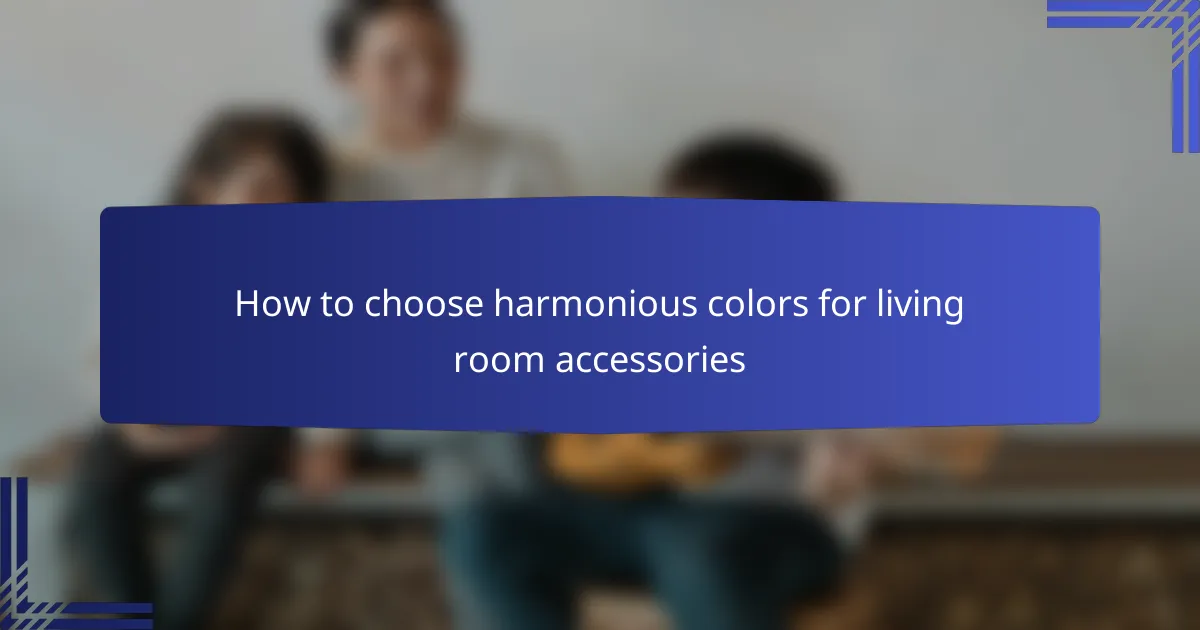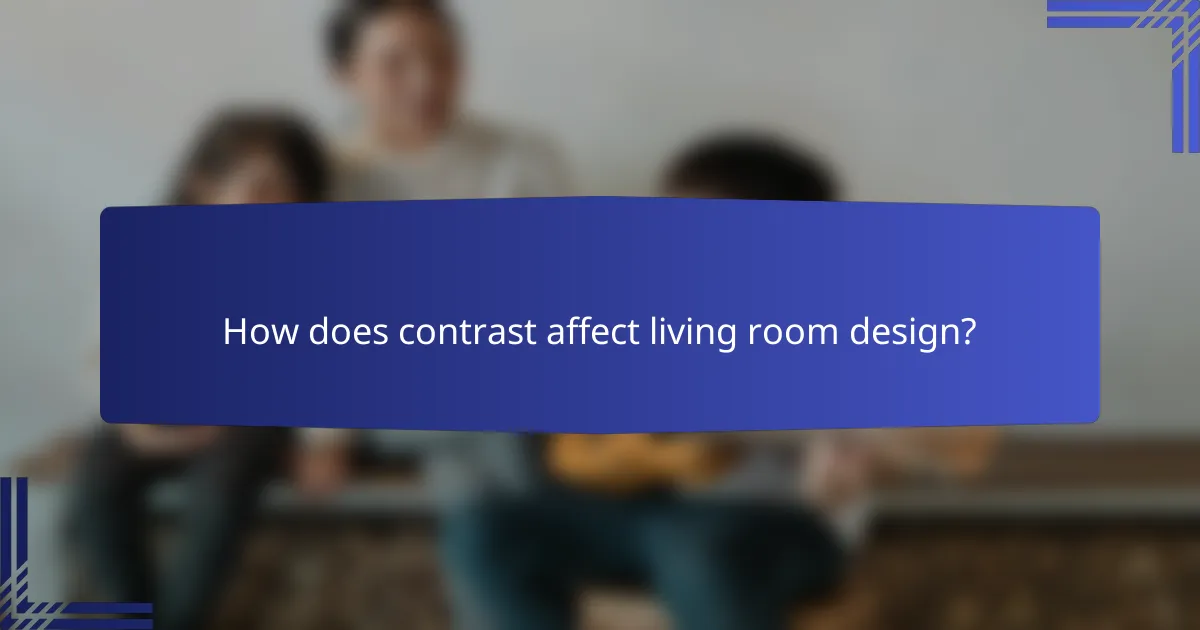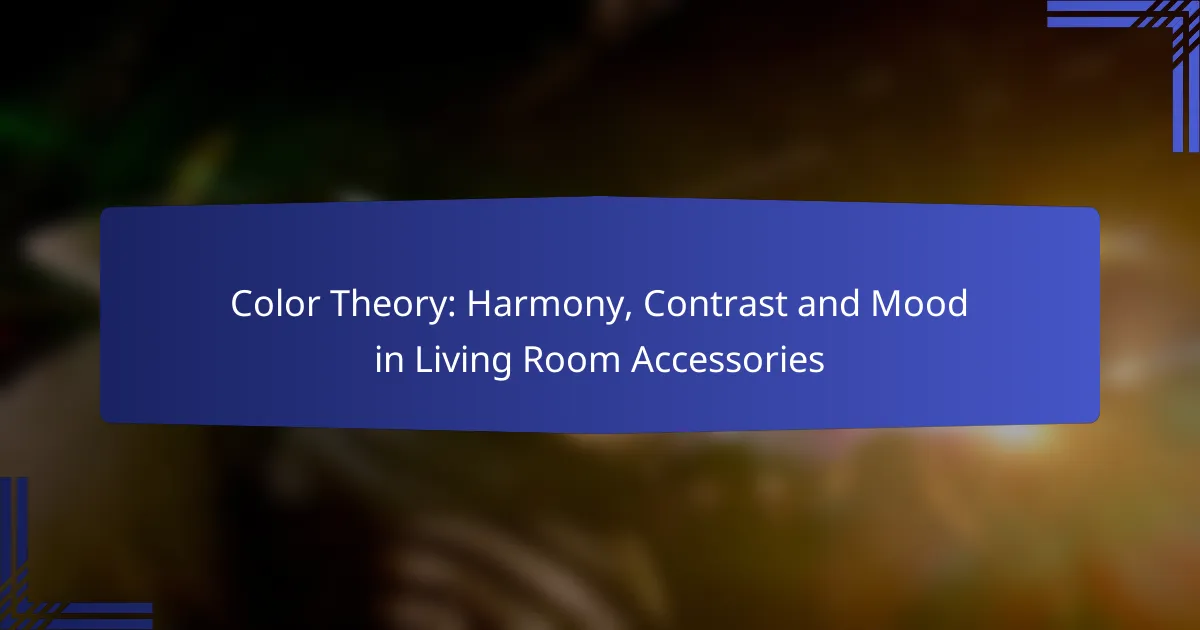Color theory plays a crucial role in selecting living room accessories, as it involves understanding the relationships between colors and their impact on the overall aesthetic. By choosing harmonious combinations, you can create a visually pleasing environment that reflects your personal style while also influencing the mood of the space. Effective use of contrast can further enhance visual interest and define areas within the room, allowing for a dynamic and inviting atmosphere.

How to choose harmonious colors for living room accessories
Choosing harmonious colors for living room accessories involves understanding color relationships and how they affect the overall aesthetic. Focus on combinations that create a pleasing visual experience while reflecting your personal style.
Complementary colors
Complementary colors are those that are opposite each other on the color wheel, such as blue and orange or red and green. Using these colors in your living room accessories can create a vibrant and dynamic look, but balance is key to avoid overwhelming the space. Consider using one color as the dominant shade and the other as an accent to maintain harmony.
For example, if you choose a blue sofa, consider adding orange cushions or artwork. This contrast can energize the room while still feeling cohesive.
Analogous colors
Analogous colors are located next to each other on the color wheel, such as blue, blue-green, and green. These colors create a serene and harmonious effect, making them ideal for a relaxing living room atmosphere. When selecting analogous colors, aim for a dominant color and two supporting shades to maintain visual interest.
An example would be a green sofa paired with soft blue and yellow-green accessories. This combination fosters a calm and inviting environment.
Triadic color schemes
Triadic color schemes involve three colors that are evenly spaced around the color wheel, such as red, yellow, and blue. This approach offers a balanced yet vibrant look, making it suitable for those who want to incorporate multiple colors in their living room. To achieve harmony, choose one color as the main focus and use the others as accents.
For instance, a yellow accent wall can be complemented by red and blue accessories, creating a lively and engaging space without feeling chaotic.
Monochromatic palettes
Monochromatic palettes utilize variations in lightness and saturation of a single color, creating a cohesive and sophisticated look. This approach is particularly effective in smaller spaces, as it can make the room feel larger and more unified. To enhance depth, mix textures and patterns within the same color family.
For example, a living room with various shades of gray can include a dark gray sofa, light gray curtains, and charcoal cushions, providing a sleek and modern aesthetic.
Color wheel applications
Understanding the color wheel is essential for applying these color theories effectively. Use it as a guide to identify relationships between colors and to create harmonious combinations. Familiarize yourself with primary, secondary, and tertiary colors to expand your options.
When selecting accessories, consider using a color wheel app or physical wheel to visualize how different colors interact. This can help you make informed decisions that enhance your living room’s overall appeal.

What are the best color combinations for mood enhancement?
Effective color combinations can significantly enhance mood in a living room. Choosing the right colors can create an inviting atmosphere, energize the space, or promote relaxation, depending on the desired emotional impact.
Warm colors for energy
Warm colors, such as reds, oranges, and yellows, are known for their energizing effects. These hues can stimulate conversation and activity, making them ideal for social spaces like living rooms.
When using warm colors, consider pairing them with neutral tones to prevent overwhelming the senses. For instance, a vibrant orange accent wall can be balanced with beige or light gray furniture.
Cool colors for relaxation
Cool colors, including blues, greens, and purples, promote a sense of calm and tranquility. These shades are perfect for creating a serene environment, making them suitable for areas intended for relaxation.
To enhance the soothing effect, opt for soft, muted versions of these colors. A pale blue sofa can be complemented with light green cushions, fostering a peaceful ambiance.
Neutral colors for balance
Neutral colors like whites, grays, and beiges serve as a versatile backdrop that balances other color schemes. They can help ground a space and allow for easy integration of both warm and cool accents.
Incorporating neutral tones can also make a room feel more spacious and airy. For example, a light gray wall can beautifully frame colorful artwork or vibrant accessories, creating visual interest without chaos.

How does contrast affect living room design?
Contrast significantly influences living room design by creating visual interest and defining spaces. It helps to highlight key features and can evoke different moods depending on the levels of contrast used.
High contrast for visual interest
High contrast in a living room can draw attention and energize the space. For instance, pairing dark furniture with light walls creates a striking effect that can make a room feel dynamic and lively.
To achieve high contrast, consider using complementary colors or stark differences in lightness. A bold black sofa against a bright white backdrop can serve as a focal point, making the room feel more vibrant.
Low contrast for subtlety
Low contrast offers a more subdued and calming atmosphere, ideal for relaxation. Soft, muted colors that are close in hue can create a harmonious environment, making the space feel cohesive and inviting.
For example, using various shades of beige or pastels can result in a serene living room. This approach is particularly effective in smaller spaces where overwhelming contrasts might feel cramped.
Contrast in textures and patterns
Incorporating contrast through textures and patterns can add depth and interest without relying solely on color. Mixing smooth surfaces with rough textures, like a sleek leather couch paired with a chunky knit throw, enhances the visual appeal.
Patterns can also play a significant role; combining geometric prints with floral designs can create a balanced look. Aim for a mix that maintains harmony while introducing variety, ensuring that the overall aesthetic remains cohesive.

What are the latest trends in living room color accessories?
The latest trends in living room color accessories emphasize a balance between boldness and subtlety, focusing on how colors can enhance mood and create harmony. Homeowners are increasingly opting for vibrant accents, earthy tones, and soft pastels to create inviting spaces that reflect personal style.
Bold accent colors
Bold accent colors are making a significant impact in living room design, as they can energize a space and create focal points. Shades like deep blues, vibrant yellows, and rich reds can be used in accessories such as cushions, throws, or artwork to draw attention and add personality.
When incorporating bold colors, consider using them sparingly to avoid overwhelming the room. A good rule of thumb is to use one or two bold accents against a neutral backdrop to maintain balance. For example, a bright orange throw pillow on a gray sofa can create a striking contrast without being too overpowering.
Earthy tones for sustainability
Earthy tones are increasingly popular as they promote a sense of calm and connection to nature. Colors like terracotta, olive green, and muted browns are not only aesthetically pleasing but also align with sustainable living practices, often being derived from natural materials.
To effectively use earthy tones, consider incorporating them through natural fabrics and textures, such as linen or jute. Accessories like woven baskets or clay pots can enhance the organic feel of the space while supporting eco-friendly choices. Aim for a palette that combines various earthy shades to create depth and warmth.
Pastel shades for softness
Pastel shades are favored for their ability to create a soft, soothing atmosphere in living rooms. Colors like blush pink, light lavender, and soft mint can evoke feelings of tranquility and comfort, making them ideal for relaxation spaces.
When using pastels, balance is key. Pair pastel accessories with neutral furniture to prevent the space from feeling too sweet or childlike. For instance, a pastel blue vase can beautifully complement a white coffee table, adding a touch of color without overwhelming the overall design. Consider mixing different pastel shades for a harmonious yet playful look.

How to effectively use color theory in e-commerce?
To effectively use color theory in e-commerce, focus on how colors influence consumer behavior and decision-making. By understanding color harmony, contrast, and mood, you can create appealing product displays that enhance the shopping experience and drive sales.
Color psychology in marketing
Color psychology plays a crucial role in marketing by influencing emotions and perceptions. Different colors evoke specific feelings; for example, blue often conveys trust, while red can create a sense of urgency. Understanding these associations helps in selecting colors that align with your brand message.
When designing product pages or advertisements, consider the target audience and the emotions you want to evoke. For instance, a luxury brand may use deep, rich colors to convey sophistication, while a children’s toy store might opt for bright, playful hues. Testing color combinations can also reveal what resonates best with your customers.
Be mindful of cultural differences in color perception. In some cultures, white symbolizes purity, while in others, it may represent mourning. Tailoring your color choices to fit the cultural context of your audience can enhance engagement and improve conversion rates.
